The Core Worlds (also known as the Galactic Core and, during the Imperial Period, the Imperial Core) were some of the most prestigious, well-developed, well-known, least politically restrictive and heavily populated planets in the galaxy. The Core was the hub of galactic culture, finance, technology, education, and fine arts. Noble houses held a great deal of influence in this region and almost every interstellar company had offices or were headquartered in the Core Worlds. In astrophysical terms, the Core denoted the central area of the galaxy, and in broad terms this was true enough, but the precise usage of the term was often more complex.
The major Rimward hyperlanes radiated outwards around little more than half the galactic disk, and the Core Worlds occupied a C-shaped region of space around the Deep Core, the heart of the astrophysical core (generally considered to be a separate outlier area), extending outwards towards the Unknown Regions.
For much of galactic history, little was known about the history and cultures of the Core Worlds prior to the formation of the Galactic Republic in 25,053 BBY. Among many prominent galactic circles, it was believed that Humans originated in one of the Core Worlds. It was widely speculated that Coruscant was the birthplace of humanity though there was little to no archaeological evidence to support that theory. Around 1,000,000 BBY, the Celestials created the Corellian system by using the massive Centerpoint Station to tractor the five planets Corellia, Selonia, Drall, Talus and Tralus through hyperspace around the star Corell. The planets were then settled with Selonians, Dralls and humans from Coruscant; resulting in the system's multi-species population. The Celestials also used similar technology to construct the Vultar system.
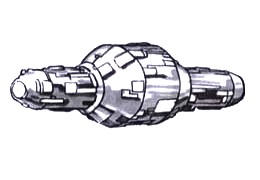
Centerpoint Station.
Millennia ago, war broke out on Coruscant between the near-Human Taungs and the 13 baseline Human nations of the Battalions of Zhell. A volcano decimated the Zhell, the ash filling the skies for two years, so the Taungs adopted the name Dha Werda Verda (Warriors of Shadow) for themselves. The Human Zhell eventually recovered and drove the Taungs offworld. Around 100,000 BBY, Coruscant and the Duros homeworld of Duro were surveyed by the Columi, who dismissed the native civilizations on these worlds as primitive disappointments. During this period, Coruscant's surface was gradually covered by the planet-spanning ecumenopolis of Galactic City. New buildings were built on the old. As a result, there was virtually no exposed land. In the forgotten underlevels of the city, there was darkness, pollution and crime. Higher up, there were government offices and penthouses owned by the elite.
In 35,000 BBY, the insectoid Killiks of Alderaan built the Castle Lands of Oroboro. At some point, the Killiks colonized nearby Alsakan. They were taken away from Alderaan 30,000 BBY by the Celestials after consuming all of Alderaan's natural resources, and long believed extinct by the galaxy until re-encountered in the Unknown Regions in 35 ABY.
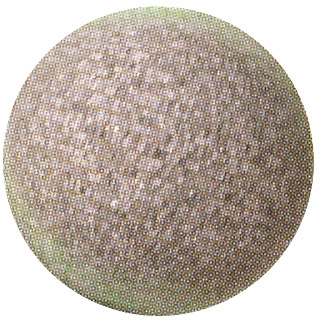
Skako in the Core Worlds
Between 35,000 BBY to 25,200 BBY, the Infinite Empire of the Rakata conquered and enslaved the inhabitants of several worlds within the Core region including, Duro and the Corellian systems. Slaves from these worlds were used to build the Star Forge in 30,000 BBY. Under Rakatan domination, the Humans of Coruscant's colonization attempts were limited to sleeper ships, which ended up on Alderaan, in the Tion Cluster, Seoul 5, Kuat, Alsakan, Axum, Anaxes, Atrisia, Metellos, Corulag, Csilla and many other worlds. The Rakata were eventually decimated by a massive plague, leading to slave revolutions on their subject worlds in the Core.
Over the next two centuries, Coruscant was linked to other Core Worlds including Corellia, Alderaan, New Plympto and Duro, by hyperspace cannons, via the Herglic Trade Empire. It was during this time that the Coruscant government peacefully absorbed the nearby Azure Imperium. During these pre-Republic years, the languages of Coruscant and its neighbors meshed to become Old Galactic Standard. Before the invention of the hyperdrive, galactic civilization was limited to the Core Worlds. Densely populated and heavily industrialized, the Core Worlds gradually developed into a socio-economic power house essential for galactic domination over the millennia.
The earliest known symbol of the Galactic Republic, dominant government of this period.
In 25,053 BBY, the Galactic Republic was born with the signing of the Galactic Constitution in the aftermath of the Unification Wars. Its founders were a number of key Core Worlds known collectively as the Core Founders including Coruscant, Alderaan, Duro, Kuat and Humbarine. As an early founder of the Republic, Duro entered a golden age under the leadership of Queen Rana Mas Trehalt. Later, the monarchy was abolished in favor of a collection of ruling corporations administrated by the Duros High House which was led by a Chief Representative Officer. During that period, Human and Duros scientists reverse-engineered the Rakatan hyperdrive; inventing the modern hyperdrive. This led to vigorous colonization in a small patch of the Core known as the Tetrahedron.
The Tetrahedron was based on the concepts of a Duros hyperspatial physicist who theorized that Coruscant, Alderaan, Corellia and the Ginn Jump were the four corners of a specific region of space. Due to its strategic location and heavy infrastructure, Coruscant was the capital of the Republic; thus bearing the coordinates 0-0-0 on hyperspace maps. The discovery of the Perlemian Trade Route linked Coruscant to the Outer Rim world of Ossus, which became the domain of the Jedi Order over the subsequent millennia and a fortress world blocking Tionese and Hutt expansion into the Core. Over the next millennia, the Corellian Run was mapped, linking Coruscant to Corellia and beyond. The wedge defined by the two trade routes became known as "the Slice." The Core Worlds' portion of the Slice was known as the Arrowhead, and soon the Republic expanded into the Colonies. Several Core Worlds like Anaxes, Basilisk and Ixtlar prospered from this territorial boom.
In 24,000 BBY, war broke out between the Republic and the Union; spreading both sides of the Perlemian. The Republic won by turning the Hutts against the Tionese; ending the Union's existence as an independent state and paving the way for galactic domination by the Core-based Republic. By 23,900 BBY, the worlds of the former Honorable Union had all joined the Republic with the exception of Desevro which remained proudly isolationist. At first, the government on Coruscant wished for slow expansion, despite its promotion of hyperspace exploration. However, against the government's wishes, the membership of the Republic boomed for its first millennium of existence, mainly due to worlds wishing to join as protection against Hutt Space.
During the Great Manifest Period (20,000 BBY–17,000 BBY), the Republic expanded eastwards across the galaxy into the Inner Rim and Expansion Region. Despite this, the Slice would remain the heart of navigable space. Eventually, the Republic expanded past the galactic-northern and -southern borders of the Slice, though most of the galaxy was still unknown, except for outposts such as Ord Mantell (12,000 BBY) and Malastare (8000 BBY). The space west of Coruscant still remained unexplored since analogues to the Perlemian Trade Route and the Corellian Run in that direction still had not been discovered. Worse, progress was limited to dangerous one- or two-light-year jumps into a stretch of hyperspatial anomalies. Consequently, the Republic government expanded eastward, instead.
During this period, several key Core Worlds including Coruscant and Alsakan established holdings in the Expansion Region. However, this region suffered greatly as a result of Alsakan attempting to snatch control of the Republic from Coruscant. This resulted in seventeen Alsakan Conflicts, spanning from 17,000 BBY to 3017 BBY. However, most of the fighting took place between their holdings in the Expansion Region, rather than in the Core itself. Needless to say, Coruscant won every conflict it fought. In 15,500 BBY, after a disastrous first contact, Coruscant was assaulted by Star Dragons in the Duinuogwuin Contention. The conflict was peacefully resolved by Supreme Chancellor Fillorean and the Star Dragon philosopher Borz'Mat'oh, who together founded the University of Coruscant.
In 12,000 BBY, the Core Worlds came under the influence of the theocratic and humanocentric Pius Dea sect which posited one of their own Contispex I as the Supreme Chancellor of the Republic. Over the following centuries, his descendants sanctioned several crusades against some rival alien sects in the Outer Rim which fought back; leaving the galaxy in a never-ending state of alternating hot and cold wars. During this period, several military outposts known as Ordnance/Regional Depots were established to ostensibly protect Human settlers from hostile alien threats. This further deepened interspecies tensions with the anti-alien nature of the crusades forcing an exodus into Hutt Space and turning the Rimward Slice into a militarized zone dominated by war profiteers. Though Pius Dea rule came to an end in 11,000 BBY, the repercussions of these crusades would sour relations between the Core and the Outer Rim over the millennia.
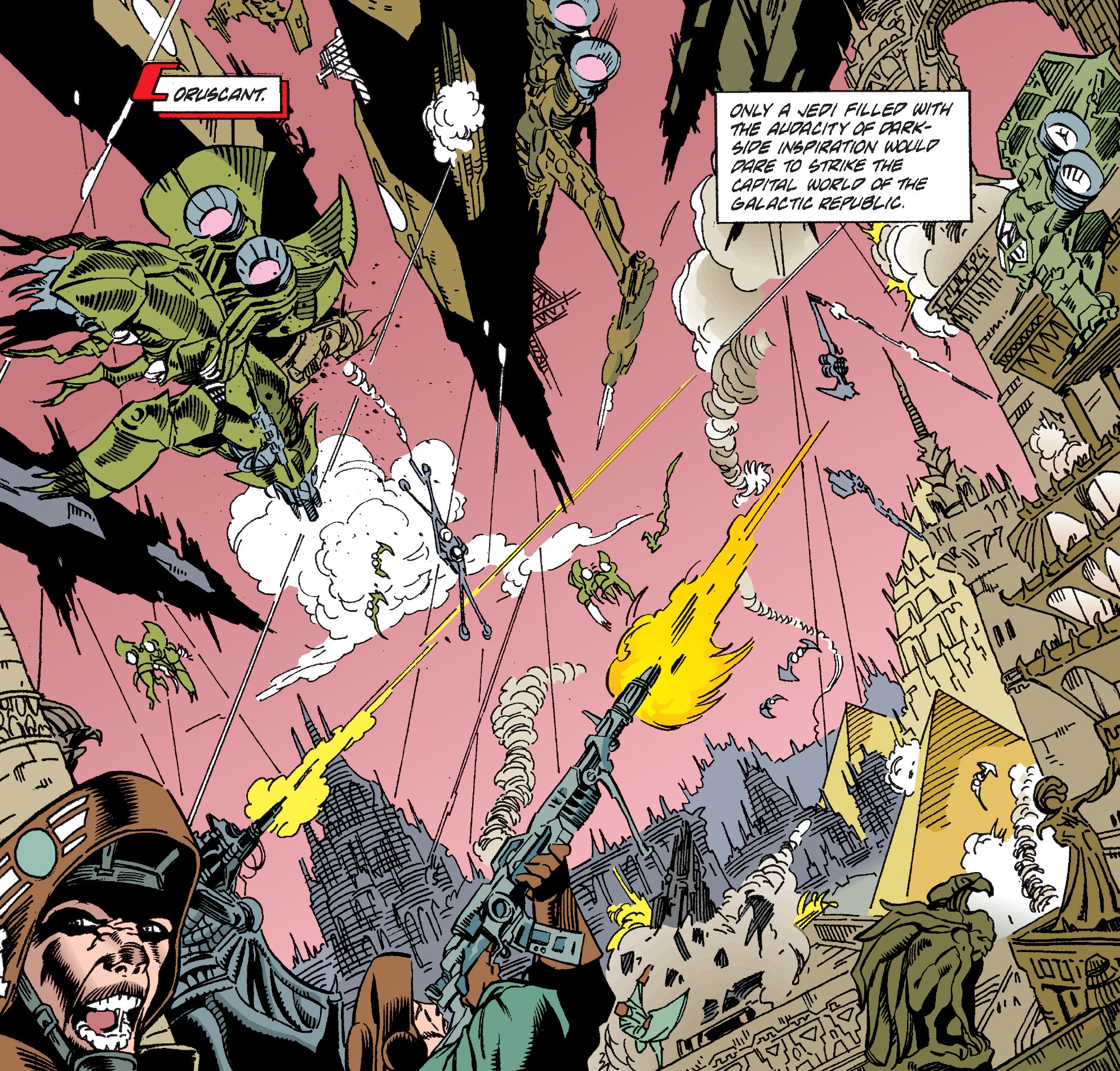
Core planets like Coruscant were the sites of key battles during the Great Sith War.
During the Great Hyperspace War in 5000 BBY, Coruscant was invaded by the Sith Empire which quickly overwhelmed the Senate District. With the destruction of Sith Lord Naga Sadow's Sith Meditation Sphere above Primus Goluud, the Sith forces were driven back by reinforcements from Anaxes. Republic forces then invaded and devastated Sith Space, ending the Sith Empire. In 4250 BBY, the Third Great Schism was fought on Coruscant with the surviving Dark Jedi fleeing to the Vultar system. The Dark Jedi discovered that the system had been artificially constructed by the Celestials and attempted to use the ancient machinery including the Cosmic Turbine but ended up destroying themselves and the system during the Vultar Cataclysm.
By 4225 BBY, Kaikielius had become impoverished and became a crime hub dominated by the Neimoidians and Hutts. A joint Jedi and Republic task force ousted the Hutts and other criminal elements, and the planet was rebuilt with Republic aid. In 4015 BBY, the Great Droid Revolution on Coruscant was defeated but sparked an increased anti-droid sentiment among the galactic populace. During the Great Sith War, the Krath and their Mandalorian allies attacked several Core Worlds including Basilisk, Foerost, Kaikielius and Coruscant. Following the devastation of Ossus in 3996 BBY, the Jedi Council took up residence in the Jedi Temple on Coruscant, to which many Jedi relics from Ossus were taken. The Temple was greatly expanded and rebuilt over the preceding millennia.
Much of the Core Worlds largely escaped the devastation of the Mandalorian Wars, the Jedi Civil War and the Sith Civil War since most of the fighting occurred in the outer galaxy. In 3962 BBY, the Mandalorians devastated much of Duro. During the Great Galactic War, the resurgent Sith Empire and their Mandalorian allies blockaded the Hydian Way; depriving the Core Worlds of vital supplies and raw goods from the Colonies and Outer Rim. This sparked rioting on Coruscant and there was talk in the Senate of complete surrender to the Sith. However, the Republic's situation was alleviated by the intervention of the Mirialan smuggler Hylo Visz who succeeded in breaking the Mandalorian blockade. The Sith then offered to negotiate a peace with the Republic on Alderaan in 3653 BBY. With the Republic and Jedi caught off guard, a Sith fleet invaded and rampaged the galactic capital; inflicting much damage to the Galactic Senate and Jedi Temple. The Republic was forced to signed the uneven Treaty of Coruscant which ceded territories to the Sith. This set the stage for the Cold War which was marked by border skirmishes and proxy wars.
In 3017 BBY, Coruscant won the Seventeenth Alsakan Conflict, ending a long line of conflicts with its rival Alsakan. This sealed Coruscant's dominance as the galaxy's political and economic center with a monopoly on sponsoring colonization and settlement of outlying systems. In 3000 BBY, Corellia StarDrive was bought out by Corellian Engineering Corporation following the death of its design team.
By 1100 BBY, the Republic had entered a "Dark Age" after centuries of protracted warfare with various Sith factions including the New Sith Empire. This period was marked by excessive corruption, corporate bankruptcy, rampant lawlessness and the exhaustion of mineral reserves. The Republic could no longer afford to maintain the HoloNet beyond the Core Worlds, so communications between worlds outside the Core had to be maintained through couriers. Even worse, a galaxywide epidemic of Candorian plague killed off as much as two-thirds of the population of some worlds. The Jedi wielded greater influence in the Republic government and took control of the office of Supreme Chancellor. Although the unity of the Sith seems to have been broken by infighting, the situation wore down the Republic Navy and Army, which likewise fell under increasing Jedi control. During the Light and Darkness War (1010 BBY–1000 BBY), Lord Kaan's reorganized Brotherhood of Darkness struck deep into the Core and managed to capture Corulag, Chandrila and Brentaal IV but failed to take the galactic capital Coruscant.
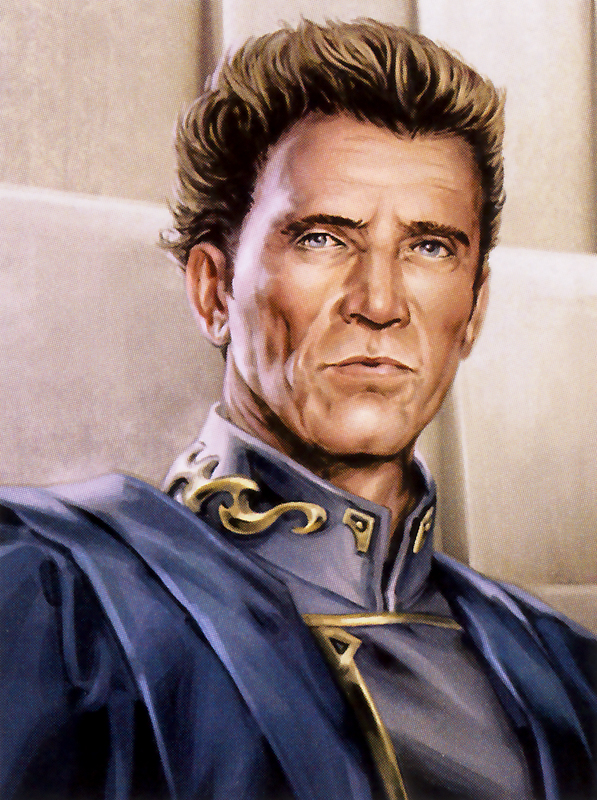
Supreme Chancellor Tarsus Valorum's Ruusan Reformation brought significant changes to relations between the Core and the "Outer Galaxy"
Following the Seventh Battle of Ruusan, Tarsus Valorum—the first non-Jedi Supreme Chancellor in centuries—enacted the Ruusan Reformation that reduced the power of the Chancellor, increased the Galactic Senate's power and abolished the Republic's military. The Ruusan Reformation also attempted to reduce corruption and decentralize power away from a few powerful Coreward sectors that dominate representation by reorganizing the then-existing millions of sectors into only 1,024 sectors. Each of the new sectors was granted its own Senator, although a few exemptions were made for politically powerful core worlds to retain their individual representation. Other slots, such as those for species types and cultural entities were also granted. By increasing the power of the Senate however, this increased gridlock and the loss of representation for many worlds and systems.
The subsequent Republic Classic era was marked by the lack of full-scale conflict in the region which largely recovered and prospered. However, small short-lived conflicts and threats still occurred. Circa 500 BBY, Corellia allied with Selonia and Drall in a failed attempt to conquer the Federation of the Double Worlds. In 470 BBY, Corellia attempted to secede from the Republic; although progressing far enough to close its sector's borders and withdraw from the Senate using Contemplanys Hermi, the plan ultimately failed and the system continued as a begrudging Republic member-state. In 380 BBY, the Corellian Jedi Keiran Halcyon defeated the Afarathu pirates, a sect of Selonian terrorists, whom were trying to kill all Humans on Corellia. The Afarathu were not gone forever, and would plague Corellia during the Galactic Civil War. In 312 BBY, the Corellian King Berethron e Solo established a parliamentary constitutional monarch, replacing his own absolute monarchy. In 150 BBY, the Royal House of Solo was overthrown by Corellia's powerful conglomerates including Gowix Computers, the Corellia Mining Corporation and the Corellian Engineering Cooperation which then proceeded to install a pro-business government known as the Diktat.
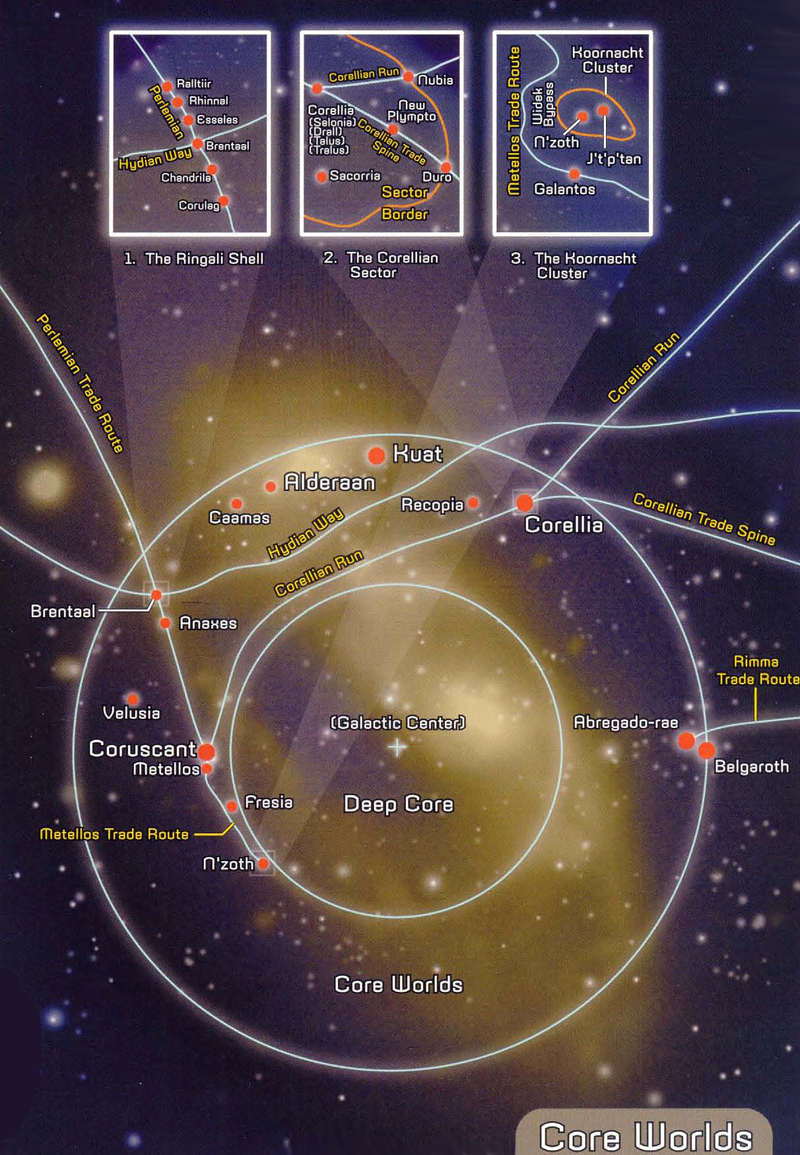
Core Worlds map dating to nearly the end of the Republic.
At some point, a group of Human inhabitants from the Core Worlds decided that the urban sprawl of their region, the stress of urban society and the lack of peaceful coexistence with others was not for them. They decided to settle Leritor, an unimportant world in the Mid Rim near the Corellian Run. In 33 BBY, the terrorist organization The Flail, accusing the Galactic Senate of corruption, disrupted public services of Coruscant, including commerce, communications, traffic and weather, destroying property and lives while doing so. They were stopped by agents of Supreme Chancellor Finis Valorum, a distant descendant of Tarsus Valorum.
Following the Naboo crisis in 32 BBY, the secret Sith Lord and Naboo Senator Palpatine became Supreme Chancellor. In 27 BBY, Coruscant was almost destroyed by Ashaar Khorda using the Infant of Shaa. Jango Fett, Zam Wesell, and Yarael Poof saved Coruscant, although Poof sacrificed himself to do so. News of this averted disaster was never widely divulged, however. By 23 BBY, the stability of the Core Worlds was threatened by the successes of Count Dooku's Confederacy of Independent Systems and the Senate was divided between supporters and opponents of the Military Creation Act. While most of the Core Worlds remained firmly loyal to the Republic, the Separatists found support in the various outlying worlds and sectors of the Expansion Region, the Mid Rim and the Outer Rim. The secession of Republic worlds like Ando and Sy Myrth resulted in a mass exodus of Aqualish and Sy Myrthians from Coruscant. In response to growing tensions, the Corellian sector under Senator Garm Bel Iblis declared neutrality and temporarily left the Republic, yet again invoking Contemplanys Hermi.
Throughout the Clone Wars, Coruscant and other Core Worlds were subject to frequent Separatist terrorist acts, assassinations and military campaigns. During the Dark Reaper crisis in 22 BBY, Separatist forces under Sev'rance Tann destroyed the planet Sarapin's geothermal generators, disrupting the region's power supply. Separatist uprisings on Brentaal IV and Esseles were quickly suppressed by Republic and Jedi forces. Coruscant itself was raided while several prominent Republic officials including former Chancellor Finis Valorum and Senator Viento were assassinated by Separatist agents. That year, the Fourth Constitutional Amendment gave Republic worlds in the Core, Colonies, and Inner Rim more voting power than worlds in the Expansion Region and beyond.
During the Foerost campaign in 20 BBY, Separatist commander Dua Ningo's Bulwark Fleet smashed through the Republic blockade at Foerost and devastated several key Republic outposts throughout the strategically-important Sector Zero. In response, the Republic launched the Victory Fleet— led by Captains Jan Dodonna and Terrinald Screed, and consisting of the newly developed Victory I-class Star Destroyers. The two fleets clashed at Ixtlar, Alsakan and Basilisk which culminated in the defeat of Ningo's forces at Anaxes. For his efforts, Screed was placed in charge of the Coruscant Home Fleet. However, General Grievous's forces succeed in capturing the Core Worlds of Kaikielius and Duro during Operation Durge's Lance. Grievous' forces also orbitally bombarded and depopulated Humbarine and unleashed the Loedorvian Brain Plague that exterminated all humans in the Weemell sector.
In 19 BBY, Republic forces under Jedi Masters Saesee Tiin and Plo Koon recaptured the strategically important world of Rendili which allowed Coruscant to seize control of the Rendili Home Defense Fleet. This and another string of victories at Duro, Commenor and Balmorra in the Colonies turned the tide of the war in the Republic's favor, forcing the Separatist fleet to retreat to the Mid and Outer Rim Territories. The Republic's capital became increasingly fortified and the humanocentric COMPOR succeeded in pressuring the Coruscant government into deporting all members of species whose homeworld had joined the Confederacy.
Despite the numerous precautions taken, the Confederacy succeeded in making a surprise raid on Coruscant. Bypassing the heavily fortified Corellian sector by use of secret hyperspace routes through the Deep Core provided by Darth Sidious, a Separatist fleet under General Grievous attacked Coruscant. With the Republic and Jedi defenders preoccupied, Grievous and his elite IG-100 MagnaGuards captured Palpatine. However, Anakin Skywalker and Obi-Wan Kenobi succeeded in rescuing the Supreme Chancellor from the infamous Separatist flagship Invisible Hand. The battle eventually turned in the Republic's favor and the Separatist armada was forced into a full retreat.
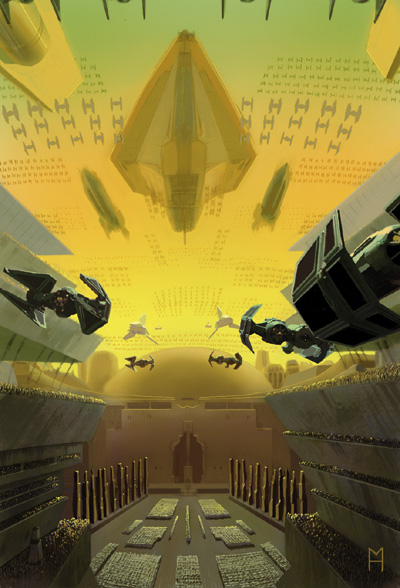
Imperial Navy forces parade over the skies of Anaxes.
At the conclusion of the Clone Wars in 19 BBY, the Republic was reorganized into the Galactic Empire. Due to its strategic location and economic power base, the Core became a key Imperial stronghold. Following Emperor Palpatine's Declaration of a New Order, Coruscant was renamed the Imperial Center. Most key Human-dominated Core Worlds including Coruscant, Kuat and Anaxes that loyally supported the Republic's war effort during the Clone Wars transferred this support to the Empire. During the Imperial period, the Republic's unofficial policy of humanocentrism became law with the Empire's promotion of Human High Culture. Non-human species on Coruscant were forced to live in segregated ethnic neighborhoods while various alien homeworlds in the Core including New Plympto, Orooturoo and Caamas were subject to Imperial atrocities. Following a prolonged resistance on pro-Separatist New Plympto led by the Purge survivor Dass Jennir, the Nosaurians were brutally subjugated and enslaved, being treated as little more than animals. In retaliation to Caamasi opposition to Imperial policies, Palpatine ordered the bombardment of Caamas in 19 BBY. Bothan agents sabotaged the planetary shields while the Imperial fleet leveled the planet's surface; destroying much of the natural environment and forcing the species offworld.
Several notable Imperial figures including Supreme Commander Gilad Pellaeon, Imperial Intelligence Director Ysanne Isard, and Governor Wilek Nereus and Commander Nahdonnis Praji came from various Core Worlds. However, the region was also home to several prominent opponents of the Galactic Empire. The founders of the Alliance to Restore the Republic Senators Mon Mothma and Bail Organa were from Chandrila and Alderaan respectively as was the former Corellian senator Garm Bel Iblis. Other prominent Alliance figures from the Core Worlds included future New Republic Chief of State Leia Organa, the Corellians Han Solo, Crix Madine and Wedge Antilles,and the former Republic Navy Captain Jan Dodonna.
During the Galactic Civil War, pro-Imperial factions began to infiltrate Ralltiir's financial system and steer its markets in favor of the Empire. This included erasing the fiscal records of alien investors. Shortly before the Battle of Yavin, Rebel sympathizers within the Ralltiiri High Council tried to stop this and restore balance to the markets. In response, an Imperial force under Lord Tion invaded the planet. Imperial forces then disbanded the High Council, placed the planet under military occupation and interned its population in camps. Tion also sealed off the entire Ralltiir system (not even permitting relief organizations to travel through his blockade), severely damaging commerce along the Perlemian.
In 0 BBY, Leia Organa went on a mercy mission to deliver medical supplies and equipment to the Raltiiri High Council. She was permitted to land by Tion himself. There, Leia rescued a wounded Rebel soldier, who later revealed the existence of the first Death Star. Shortly later, the Death Star under the command of Darth Vader and Grand Moff Tarkin destroyed the prominent Core world of Alderaan; killing billions and prompting many outraged sentients to support the Rebel Alliance. Shortly afterwards, the Death Star was destroyed at the Battle of Yavin. In 1 ABY, Coronet City, the Corellian capital, was the site of a heated skirmish between Imperial forces and elements of the Alliance including the elite Rogue Squadron whom succeeded in rescuing the former Storm Commando Madine from Imperial custody.
In 3 ABY, a Rebel team led by Leia infiltrated Coruscant in an attempt to solicit the Falleen Black Sun leader Prince Xizor's assistance in uncovering the assassins who were targeting Alliance leader Luke Skywalker. However, this proved to be a trap and Skywalker hatched a plot to rescue the Alliance delegates. In the ensuing skirmish, Xizor's palace was destroyed and the Prince himself met his demise at the hands of Vader whose flagship Executor obliterated Xizor's skyhook. Taking advantage of the chaos, the traitorous Grand Admiral Demetrius Zaarin attempted a coup against the two Sith Lords but was eliminated by loyalist Imperial forces.

New Republic forces capture Coruscant in 6 ABY.
During the late stages of the Galactic Civil War, the Core Worlds switched hands several times between the New Republic and the Empire. With the death of the Emperor and Darth Vader during the Battle of Endor in 4 ABY, the region was carved up by various Imperial warlords. Coruscant was the site of a short-lived anti-Imperial uprising which was suppressed by Imperial forces under the Grand Vizier Sate Pestage and Isard. While the former assumed control of the galactic capital, he was challenged by the Imperial Ruling Council which was secretly manipulated by Isard. In 5 ABY, the Alliance's successor state the New Republic captured Ralltiir, Esseles and Brentaal IV, the latter an influential Core World near Chandrila. Isard manipulated Pestage into losing strategically-important Brentaal to the New Republic as a means of undermining the latter's position in power.
When Pestage's secret negotiations with the New Republic to cede Coruscant in exchange for an independent fiefdom in the Outer Rim became public, the Ruling Council used this as an opportunity to seize control of Coruscant. Pestage was incarcerated by local Imperial authorities on Ciutric IV; prompting the New Republic to attempt a rescue operation to encourage more defections. This attempt failed and Pestage was murdered by the warlord Admiral Delak Krennel, who then took over Pestage's fiefdom. Meanwhile, Isard liquidated the entire Ruling Council and took over control of Coruscant; turning the capital into a fortress world against the advancing New Republic by fortifying it with Imperial reinforcements.
In 6 ABY, Coruscant fell to Republic forces without intense fighting after Alliance agents sabotaged the planet's shield generators. However, Isard had disappeared and infected the capital's alien populations with the deadly Krytos virus as a means of stirring tensions between humans and aliens. While the Republic managed to treat the virus with shipments of bacta from Thyferra following the Bacta War, interspecies tensions remained rife. Later, Isard escaped Coruscant on the Executor-class Star Dreadnought Lusankya, which doubled as a private prison buried beneath layers of urban sprawl. The event generated earthquakes which killed millions.
In 9 ABY, Grand Admiral Thrawn's forces seeding the space surrounding Coruscant with cloaked asteroids; effectively blockading the New Republic capital by disrupting space traffic and preventing the planetary defense forces from lowering the world's shield generators. With Thrawn's death, the blockade was ended. With the defeat of the Imperial warlord Krennel's forces, the New Republic deployed the majority of its Core-based naval units into the Outer Rim, leaving the strategically important region undefended.
In 10 ABY, after Grand Admiral Thrawn was assassinated during the Battle of Bilbringi, the Imperial Ruling Council under Ars Dangor's leadership gathered Imperial warlords to organize a brutal blitzkrieg that recaptured several key systems in the Core Worlds with days. Ralltiir, Chandrila, Duro, Kaikielius, Esseles, and Metellos were quickly taken over by the Imperial forces. Admiral Sander Delvardus commenced an orbital bombardment during the Battle of Metellos, killing five billion inhabitants of the planet. A sizable Imperial armada bombarded Coruscant, forcing Chief of State Mon Mothma to evacuate the capital's population and relocate the New Republic to the Outer Rim. The Empire invaded the galactic capital and the Ruling Council summoned the political leaders and military commanders of the Empire to restore Imperial government. However, the Empire fell into a civil war that devastated Coruscant and caused widespread destruction in the Empire. After several months of infighting between rival Imperial fleets and armies, Emperor Palpatine returned to conquer the galaxy. Following his first death during the Battle of Endor, Palpatine was reincarnated in a clone body at his secret throneworld of Byss in the remote Deep Core. Having regained the Core Worlds, Palpatine was able to launch Operation Shadow Hand which targeted various "rebellious worlds" such as Dac, Balmorra and Da Soocha V.
With his final death in 11 ABY, the New Republic reclaimed most of the Core while the Empire was pushed backed to the Deep Core and regions in the Outer Rim, that became collectively known as the Imperial Remnant. The term "Imperial Core", or sometimes even simply "the Core", was used by supporters of both sides to denote areas of remaining Imperial control around the Galactic Center. This usage persisted even when Coruscant and most of the historic Core Worlds had joined under New Republic, and the Imperial holdouts in the area were mostly restricted to the Deep Core and the fringes of the Unknown Regions.
Until 25 ABY, the Core Worlds remained largely stable and prosperous except for brief minor disturbances like the Corellian Crisis and the Second Imperium Crisis. During the Black Fleet Crisis (16–17 ABY), the New Republic Fifth Battle Group was deployed against the xenophobic Yevethan Duskhan League which perpetuated genocide in the Koornacht Cluster. In 17 ABY, the Senate Hall on Coruscant was bombed during the Almanian Uprising; killing and wounding many senators. Core-based Republic forces were also deployed against the Deep Core warlords.
During the Corellian Crisis in 18 ABY, the Sacorrian Triad attempted to secede the Corellian sector by supporting various separatist factions in the Corellian system and then kidnapping a Republic delegation led by Chief of State Leia. However, one of these groups—the extremist Human League led by Thrackan Sal-Solo turned on their Triad bosses by using Centerpoint Station to generate an interdiction field that blocked all travel to and from the system. The Sacorrian Triad used Centerpoint to destroy three planetary systems in the Core including Bovo Yagen.
Tensions between the Human League and its Sacorrian backers reached a climax when Thrackan attempted to secede the sector with himself as leader. Deactivating the interdiction field, the Sacorrians deployed a war fleet which was by Bakuran and New Republic forces during the Battle of Centerpoint Station. With this defeat, the New Republic reasserted control over the Corellian sector and apprehended the rebels. To alleviate tensions between the region and the Coruscant government, the Drall Marcha was appointed the sector's new Governor-General. However, many Corellians still yearned for independence and resented New Republic intervention. Despite the normalization of foreign relations and trade with the Imperial Remnant in 19 ABY, the Republic still faced resistance from splinter factions like the Second Imperium which raided Coruscant for supplies and recruits in 23 ABY.
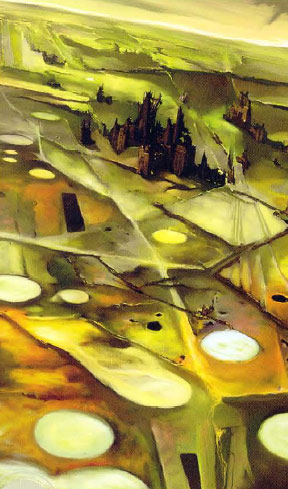
A green Duro following the Yuuzhan Vong War
During the Yuuzhan Vong War (25-29 ABY), the Core Worlds were an important target for the extra-galactic Yuuzhan Vong in their path for galactic domination. Since Yuuzhan Vong advances were initially concentrated in the outlying Outer Rim, the Core Worlds were reluctant to commit resources and indifferent to the plight of outlying worlds. In 26 ABY, this changed with further Yuuzhan Vong advances into the Mid Rim, Expansion Region, Hutt Space, the Inner Rim and an ill-fated strike on Fondor in the nearby Colonies. Under the auspices of the Senate Select Committee for Refugees, billions of displaced refugees were relocated to Duro which was believed to be safe from further enemy incursions.
However, the newly arrived Warmaster Tsavong Lah ordered a change in battle plans and the planet was attacked by a massive Yuuzhan Vong fleet which destroyed the planet's orbital cities and killed many refugees. In an attempt to stir anti-Jedi sentiment, the Yuuzhan Vong offered to cease their invasion in exchange for all Jedi being handed over to the invaders. Several prominent Core Worlds politicians including Senator Viqi Shesh and Corellian Governor-General Thrackan Sal-Solo covertly collaborated with the invaders. Following their success at Duro, Yuuzhan Vong forces seized New Plympto and Talfaglio in the Corellian sector in 27 ABY, followed by Ralltiir, Kuat and Kaikielius.
On New Plympto, they were opposed by a resistance army led by the Twi'lek Jedi sisters Alema and Numa Rar. In response, the Yuuzhan Vong occupiers depopulated the planet with a virus. In response to New Republic resistance, the Yuuzhan Vong attempted to execute refugees in Talfaglio but were thwarted by a Jedi raid. In response, the invaders attacked the galactic capital Coruscant with a massive fleet. During the subsequent battle, both sides sustained massive casualties and the Chief of State Borsk Fey'lya was slain.
The Yuuzhan Vong then proceeded to terraform Coruscant in the image of their primeval homeworld of Yuuzhan'tar. They introduced exotic species from their home galaxy, altered much of the planet's landmarks and even altered its climate by using dovin basals to shift it closer to Coruscant Prime. Much of the former cityscape was covered in vegetation while one of its moons was destroyed to create a large asteroid field known as the Rainbow Bridge. Thus, Coruscant became the center of the new Yuuzhan Vong empire. Similar projects were undertaken on Duro which was transformed into a lush forested world; reversing millennia of pollution and neglect.
In 29 ABY, the New Republic's successor state—the Galactic Federation of Free Alliances retook Coruscant following a massive battle that saw the demise of the Yuuzhan Vong Supreme Overlord Shimrra Jamaane and a class uprising among the lowly Worker caste and Shamed Ones inspired by the nascent Jeedai heresy. The Yuuzhan Vong were relocated to the sentient world of Zonama Sekot—a seed of the original Yuuzhan'tar. With the recapture of Coruscant and the reversal of the terraforming processes, Coruscant once again assumed its role as the galactic capital in 30 ABY.
Following its reconstruction, Coruscant again became the galactic capital while the Core Worlds gradually recovered its former economic and cultural power. On Duro, Yuuzhan Vong terraforming efforts succeeded in restoring a lush, habitable environment. During the Second Galactic Civil War, peace and recovery efforts were hampered by fighting between the Alliance and the secessionist Confederation led by the Corellian system and the Bothans. In 40 ABY, Chief of State Cal Omas was overthrown by the former Jedi-turned Sith Lord Jacen Solo and Cha Niathal which divided the Alliance further into factions loyal to Jacen and the opposition Jedi Coalition. With the end of fighting in 41 ABY, former Imperial admiral Natasi Daala became the new Chief of State though the Core Worlds remained divided between the Alliance and Confederation.
Prior to the Sith–Imperial War, the Galactic Alliance and the Fel Empire signed a treaty on Anaxes where the two would defend each other in the events of threat from aggressive powers. Following the sabotage of the Ossus Project, the Fel Empire took advantage of rampant anti-Vong sentiment to invoke war on the Galactic Alliance. Within three years, much of the Core including Coruscant passed into the hands of the Fel Empire under Roan Fel which was usurped by Darth Krayt's Sith Empire in 130 ABY. The now lush world of Duro became an Imperial stronghold and was the site of the Imperial Naval Academy where the most talented Duros instructed Imperial pilots and capital ship crewmen.
As of 137 ABY, resistance to the Sith-led Empire in the Core Worlds continued in the form of the Alliance's Core Forces under Admiral Gar Stazi throughout the Second Imperial Civil War. While much of the fighting occurred in the Outer Rim Territories, the Temple of the Sith on Coruscant was raided by the former Jedi Cade Skywalker. Later, a joint Galactic Alliance and Fel Empire fleet attacked Ralltiir and decimated the Coruscant Third Fleet; forcing the Sith Empire to divert more forces to defend the strategically important Core world.
The Core Worlds were subdividied into a number of sectors, which included:
- Jedi Academy: Return of the Padawan
- LEGO Star Wars: The Video Game
- LEGO Star Wars: The Complete Saga
- LEGO Star Wars II: The Original Trilogy
- LEGO Star Wars: The Padawan Menace
- LEGO Star Wars: The Quest for R2-D2 film